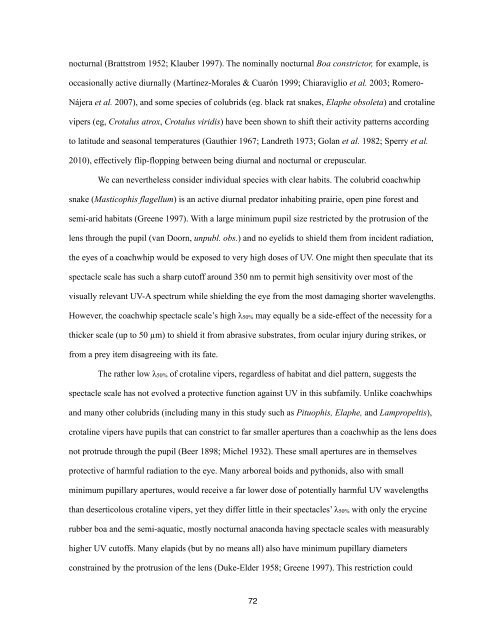Chapter 1, The Reptilian Spectacle - UWSpace - University of ...
Chapter 1, The Reptilian Spectacle - UWSpace - University of ...
Chapter 1, The Reptilian Spectacle - UWSpace - University of ...
Create successful ePaper yourself
Turn your PDF publications into a flip-book with our unique Google optimized e-Paper software.
nocturnal (Brattstrom 1952; Klauber 1997). <strong>The</strong> nominally nocturnal Boa constrictor, for example, is<br />
occasionally active diurnally (Martínez-Morales & Cuarón 1999; Chiaraviglio et al. 2003; Romero-<br />
Nájera et al. 2007), and some species <strong>of</strong> colubrids (eg. black rat snakes, Elaphe obsoleta) and crotaline<br />
vipers (eg, Crotalus atrox, Crotalus viridis) have been shown to shift their activity patterns according<br />
to latitude and seasonal temperatures (Gauthier 1967; Landreth 1973; Golan et al. 1982; Sperry et al.<br />
2010), effectively flip-flopping between being diurnal and nocturnal or crepuscular.<br />
We can nevertheless consider individual species with clear habits. <strong>The</strong> colubrid coachwhip<br />
snake (Masticophis flagellum) is an active diurnal predator inhabiting prairie, open pine forest and<br />
semi-arid habitats (Greene 1997). With a large minimum pupil size restricted by the protrusion <strong>of</strong> the<br />
lens through the pupil (van Doorn, unpubl. obs.) and no eyelids to shield them from incident radiation,<br />
the eyes <strong>of</strong> a coachwhip would be exposed to very high doses <strong>of</strong> UV. One might then speculate that its<br />
spectacle scale has such a sharp cut<strong>of</strong>f around 350 nm to permit high sensitivity over most <strong>of</strong> the<br />
visually relevant UV-A spectrum while shielding the eye from the most damaging shorter wavelengths.<br />
However, the coachwhip spectacle scale’s high λ50% may equally be a side-effect <strong>of</strong> the necessity for a<br />
thicker scale (up to 50 µm) to shield it from abrasive substrates, from ocular injury during strikes, or<br />
from a prey item disagreeing with its fate.<br />
<strong>The</strong> rather low λ50% <strong>of</strong> crotaline vipers, regardless <strong>of</strong> habitat and diel pattern, suggests the<br />
spectacle scale has not evolved a protective function against UV in this subfamily. Unlike coachwhips<br />
and many other colubrids (including many in this study such as Pituophis, Elaphe, and Lampropeltis),<br />
crotaline vipers have pupils that can constrict to far smaller apertures than a coachwhip as the lens does<br />
not protrude through the pupil (Beer 1898; Michel 1932). <strong>The</strong>se small apertures are in themselves<br />
protective <strong>of</strong> harmful radiation to the eye. Many arboreal boids and pythonids, also with small<br />
minimum pupillary apertures, would receive a far lower dose <strong>of</strong> potentially harmful UV wavelengths<br />
than deserticolous crotaline vipers, yet they differ little in their spectacles’ λ50% with only the erycine<br />
rubber boa and the semi-aquatic, mostly nocturnal anaconda having spectacle scales with measurably<br />
higher UV cut<strong>of</strong>fs. Many elapids (but by no means all) also have minimum pupillary diameters<br />
constrained by the protrusion <strong>of</strong> the lens (Duke-Elder 1958; Greene 1997). This restriction could<br />
72
















